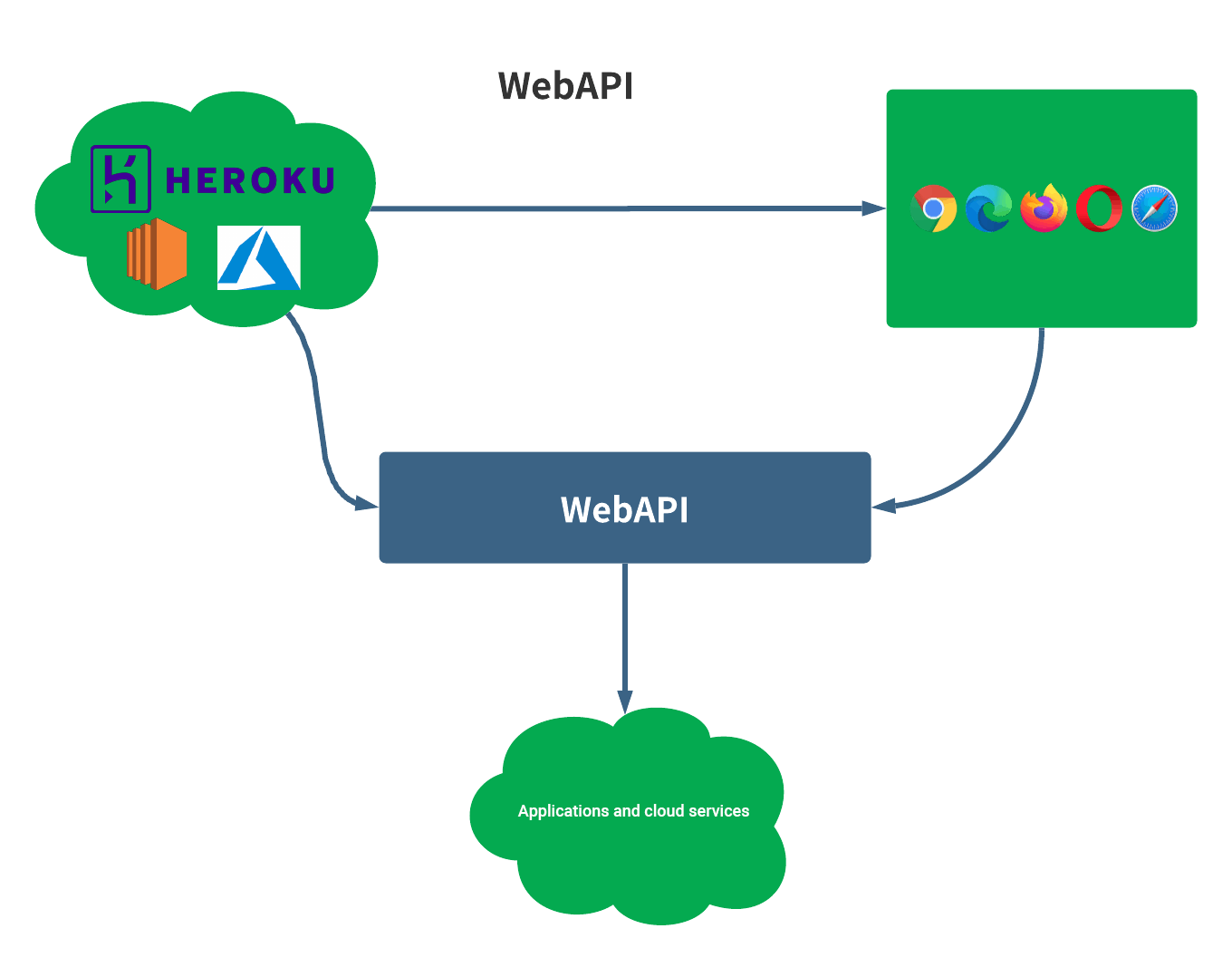
In this article, you will get an easy-to-understand explanation of what an API is and how you can use them to enhance your software applications or services.
What is an API?
API stands for application programming interface. It refers to a set of rules, protocols, and tools for building software and applications, allowing different software programs to communicate with each other. APIs specify the way software components should interact, making it possible to exchange data and execute functions or commands between separate software products.
By calling the API of a service, you can use its specific features in your own applications or services. This allows you to reduce development and testing time (and costs) compared to developing that functionality from scratch. You also benefit from any new features provided by the API. By using a flexible API, even without knowing exactly how to implement a particular feature, you can incorporate best practices developed by professionals. This opens up opportunities for innovation and efficiency.
Here’s an example: many online shops have incorporated Amazon Pay. Customers can choose Amazon Pay on the purchase screen, request information like addresses and credit card details, receive responses, and have the fields populated on the screen without inputing them manually, making payments easier for users. Because these online shops do not store customers’ credit card information, customers can shop more securely. The server management costs of online shops are also reduced.
The basic process of an API consists of “Request” and “Response.” A client sends a request to the API to retrieve information or perform an operation, and the API processes this request and sends back the appropriate response, which contains the requested data or the outcome of the operation.
Advantages and benefits of APIs
APIs allow you to use specific features without having to implement them yourself, enabling you to follow best practices. APIs eliminate the need to develop and test products or services from scratch, saving software development resources and reducing the burden on developers.
Specific benefits include:
- Efficient development
- Cost reduction
- Improved user experience
- Strengthened security
Benefit 1: Efficient development
With APIs, you can develop applications more efficiently as you do not have to start from scratch. While it may be typical to build features from scratch when developing a project for personal use, when working on larger projects or commercial applications, leveraging APIs can save significant time and resources by reusing existing services and functionalities.
For example, you can use notification features via APIs to integrate error notifications into your software software. Trying to develop an entire notifications service from scratch would be incredibly time-consuming, whereas using APIs increases efficiency.
Benefit 2: Cost reduction
Efficient development reduces both time and resources spent on development activities, naturally leading to cost reduction. Even if you were to develop and deploy a service in-house, errors and bugs would arise, and version updates would be needed. APIs allow you to offload those efforts onto a third party, saving in the short and long term, development costs can be reduced.
Benefit 3: Improved user experience
Leveraging APIs can significantly enhance the user experience by integrating advanced features and functionalities without the need for extensive development time.
For example, with the error notification feature discussed in Benefit 1, if you need to notify users in different ways such as email, chat, or SMS (using services from other companies), you would need to make use of APIs from each service provider. Leveraging and providing each company’s notification channel APIs can be extremely convenient while also ensuring that users have a smooth and engaging experience.
Benefit 4: Increased customer satisfaction
Using APIs to provide services tailored to customer needs can enhance customer satisfaction.
By integrating third-party services through APIs, such as personalized recommendations, real-time tracking, or instant customer support, businesses can offer a more customized and responsive user experience. This level of personalization and efficiency in meeting user demands leads to higher customer satisfaction, fostering loyalty and potentially increasing customer retention rates.
Benefit 5: Strengthened security
Leveraging APIs can also strengthen security by allowing developers to implement robust authentication and encryption protocols managed by external experts. This means that sensitive data can be handled more securely, benefiting from the continuous updates and security patches provided by the third-party services. As a result, applications can maintain high levels of security without requiring developers to be experts in every aspect of cybersecurity, thus safeguarding user data more effectively.
What is a WebAPI?
Up to this point, we have discussed the general aspects of APIs. In fact, there are several types of APIs available, and they all have specific use cases. WebAPI includes REST (REpresentational State Transfer), SOAP (Simple Object Access Protocol), RPC (Remote Procedure Call), and more.
WebAPI refers to APIs that facilitate the exchange of data on the web using the HTTP protocol. By leveraging WebAPI, individuals and companies can incorporate specific functionalities or data from other sites into their own sites or applications. This can lead to benefits like increased development efficiency, cost savings, and enhanced convenience.
WebAPI use cases
Online shopping sites are an illustrative example of what a WebAPI is. Companies like Amazon and Rakuten provide APIs, allowing individuals to display information from these sites on their own websites. This has made it possible for individuals and companies to generate significant amounts of affiliate revenue. You may have noticed Amazon or Rakuten ads when browsing blogs or other platforms.
Social media platforms are another example. You have likely experienced using your social media credentials to log into a variety of sites. This can be an improvement for customers, who don’t need to register as members on the new site and create new login information to keep track of.
What is REST?
REST stands for REpresentational State Transfer, which serves as a software architecture model for web services design. Instead of being a set of protocols or standards, REST is based on four universally recognized principles.
The 4 principles of REST
- Principle 1 - Addressability: All information can be represented using a single URL on the web.
- Principle 2 - Statelessness: Each request is completely isolated and self-contained, without any need for session or state management.
- Principle 3 - Connectedness: Resources should be interlinked, allowing users to navigate through different pieces of information easily.
- Principle 4 - Uniform interface: The API should provide a consistent interface for interacting with resources, including standardized ways to read (GET), create (POST), update (PUT), and remove (DELETE) information, all using HTTP methods.
A web service that adheres to all these principles can be called a RESTful service.
What is a REST API?
APIs developed following REST principles are known as REST APIs (RESTful APIs).
When an HTTP request is made to a REST API, the server processes the request accordingly and sends data to the endpoint in formats such as JSON (JavaScript Object Notation), HTML, XLT, Python, PHP, or plain text. JSON is the most commonly used format. The data is then displayed at the endpoint in a visually comprehensible manner, using text or images.
REST APIs use headers and parameters, with HTTP methods (GET, POST, PUT, DELETE) playing a vital role. Headers provide descriptive information about the data that follows. Requests and responses have unique HTTP connection information and status codes in their headers. Parameters specify the conditions for information, containing essential ID information related to metadata, authorization, URIs, caching, cookies, and more.
7 rules of REST APIs
The 7 rules of REST APIs are:
- It is a server architecture comprising clients, servers, and resources.
- It arranges data in layers that cannot be directly accessed by users.
- It transfers information using standardized data.
- Requests are made using HTTP requests.
- It is stateless in nature.
- It enables caching to enhance client-server interactions.
- It allows the transfer of code from server to client for execution, integrating a code-on-demand architecture style.
By utilizing URI and HTTP methods, a REST API enables standardized request consistency, making it clear which resource is being accessed. It also enhances scalability to cater to increased loads, making it ideal for IoT (Internet of Things) and mobile application development.
What is SOAP?
SOAP, an abbreviation for Simple Object Access Protocol, is a protocol that exchanges data in XML format through HTTP requests and responses. It is common for many people to confuse SOAP with REST API. However, a major difference is that SOAP is a protocol, while REST is an architecture.
Conclusion
In this article, you learned all about APIs. By using APIs, you can easily integrate existing services with your own applications, allowing for efficient service deployment. APIs reduce development costs and increase efficiency, among many other benefits. The different types of APIs accommodate a variety of use cases, so be sure to explore their potential for improving your software development projects.
CircleCI’s API solutions
If you are building API-powered applications, CircleCI can help you accelerate development times and improve software quality by automating the build, test, and deployment stages of your workflows. To get started, sign up for a free account and learn more about effective API development in these resources:
Similar posts you may enjoy

Hyperparameter tuning for LLMs using CircleCI matrix workflows

Senior NLP Researcher

End-to-end testing and deployment of a multi-agent AI system with Docker, LangGraph, and CircleCI

Data Scientist

How to set up chaos engineering in your CI/CD pipeline with CircleCI and Chaos Toolkit

Software Engineer

